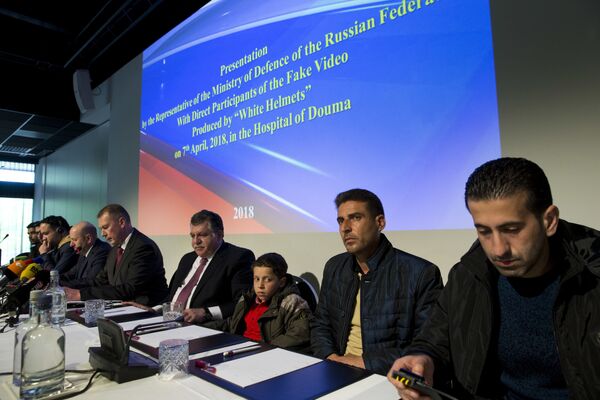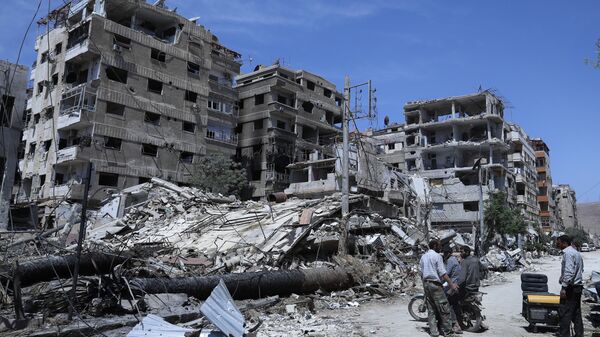On April 14th 2018, the US, France, and Great Britain launched missile strikes on Syria, in retribution for an alleged poison gas attack on the terrorist stronghold Douma for which they held the Syrian government responsible. Just before the attack, the Russian ambassador in Lebanon and the chief of Russia’s general staff warned Russia would respond to strikes on Syria if the lives of Russian servicemen were threatened, targeting any missiles and launchers involved. As Russian envoy to Organisation for the Prohibition of Chemical Weapons (OPCW), Alexander Shulgin, later put it: "There was a smell of gunpowder in the air".
What could have led to World War III eventually ended with a hiss. No Russian targets were hit and for Syria, the damage from the attacks was limited, partly because Syria’s Soviet-era air defence systems intercepted many incoming missiles.
Rumours about a chemical attack had started with videos and photos disseminated on social media by Syrian Civil Defence, better known as The White Helmets, among others, of children being treated in a hospital with respiratory problems; of dead bodies in an apartment building; and of chlorine cylinders that looked as if they had been dropped from the sky, one laying on a roof terrace and the other on a bed under a hole in the roof.
On 16th April 2018, two days after the tripartite strike, British Middle East correspondent Robert Fisk interviewed a doctor from the Douma hospital. He stated that although the video of the children being treated in the hospital was real, and that the portrayed patients had been struggling with breathing problems, this was not the result of a poison gas attack, but of dust clouds caused by bombardments that had occurred earlier in the day.

While the patients were being brought in, there was a member of the White Helmets calling out "gas!" – which caused people to throw water over each other in panic.
Other witnesses, who told their story in The Hague on April 28th 2018, at a press conference organised by the Russian delegation to OPCW, roughly confirmed the statement of the doctor interviewed by Fisk. None of them, including several people who were seen in the video, said they hadn't noticed anything of a poison gas attack.
In May 2019 a revealing document was leaked from OPCW about the two cylinders. The author, Ian Henderson, who in April 2018 had been sent to Douma to investigate the cylinders on behalf of the chemical watchdog, concluded that there was a "higher probability that both cylinders were manually placed at those two locations rather than being delivered from aircraft". This seemed to be an understatement since the hole in the roof turned out to be smaller than the cylinder on the bed below.
Also "no organophosphorus nerve agents or their degradation products were detected, either in the environmental samples or in plasma samples from the alleged casualties", the OPCW interim report on the Douma incident reads. The OPCW inspectors furthermore noted that the dead people in the photos and videos didn't look like victims from "chlorine-containing choking or blood agents such as chlorine gas, phosgene or cyanogen chloride".
And so, one important question remains unanswered: Who were the around 35 dead deceased, mostly women and children, that were filmed and photographed in the four-storey building in Douma, where one of the two cylinders was found on the roof? And how did they die?
Jaish al-Islam, the terrorist group that at that time occupied Douma, reportedly buried the bodies in an unmarked mass grave, before the OPCW inspectors had arrived at the scene. Raed Saleh, leader of the White Helmets, told Reuters he pinpointed the burial place to OPCW. Nevertheless, the chemical watchdog chose not to conduct exhumations.
And so I asked Al Saleh if he could tell me anything about the background of the victims and the location of their burial. Unfortunately, he left my questions unanswered. I also asked Dr. Ghassan Obeid of the mission of Syria to the OPCW if the Syrian authorities had made an effort to identify the deceased, but I received no reply from him either.
At a press conference of the Russian embassy in The Hague on July 12th 2019, that I attended, Maxim Grigoriev, director of the Russia-based Foundation for the Study of Democracy, showed interviews of people living in the apartment building and in its vicinity.

None of them recognised the deaths from the videos and photos, apart from one man who identified his brother, who had died, he said, from artillery shelling elsewhere. Some interviewees declared they had seen fighters bringing dead bodies into the building.
I invited the open-source and social media investigators of Bellingcat to debunk Grigoriev's findings and to identify the 'Douma victims'. I received no reply. Nevertheless, Bellingcat proved to be very quick in finding who was to blame: four days after the alleged chemical attack they concluded it was "highly likely the 34+ victims of the 19:30 attack on the apartment building near al-Shuhada Square were killed as a result of a gas cylinder filled with what is most likely chlorine gas being dropped from a Hip helicopter originating from Dumayr Airbase".
And so here we are, two years after an attack that never happened, with around 35 dead people, still unidentified, and still buried in an unmarked grave.
Even more terrible: the management of OPCW, based in The Hague, The Netherlands, has suppressed the findings of its own inspectors who had conducted an investigation at the alleged crime scene in Douma, Syria.
The OPCW management is simply covering up for the criminal elements that have staged the Douma incident, and that could have triggered an all-out world war. For full information about this alarming fact, I recommend reading the presentation given by members of the Working Group on Syria, Media, and Propaganda among others in the House of Commons on January 22th 2020.


